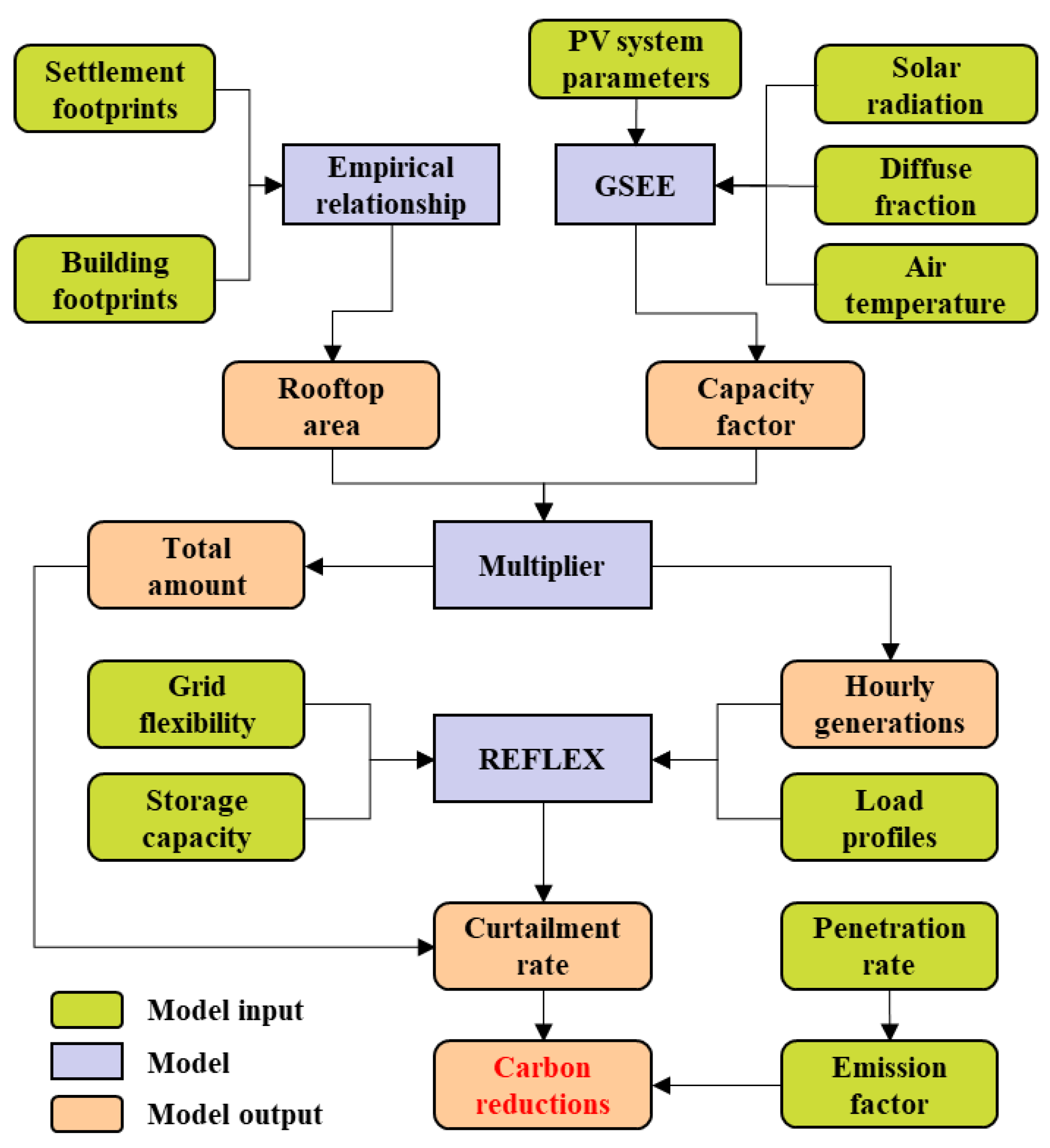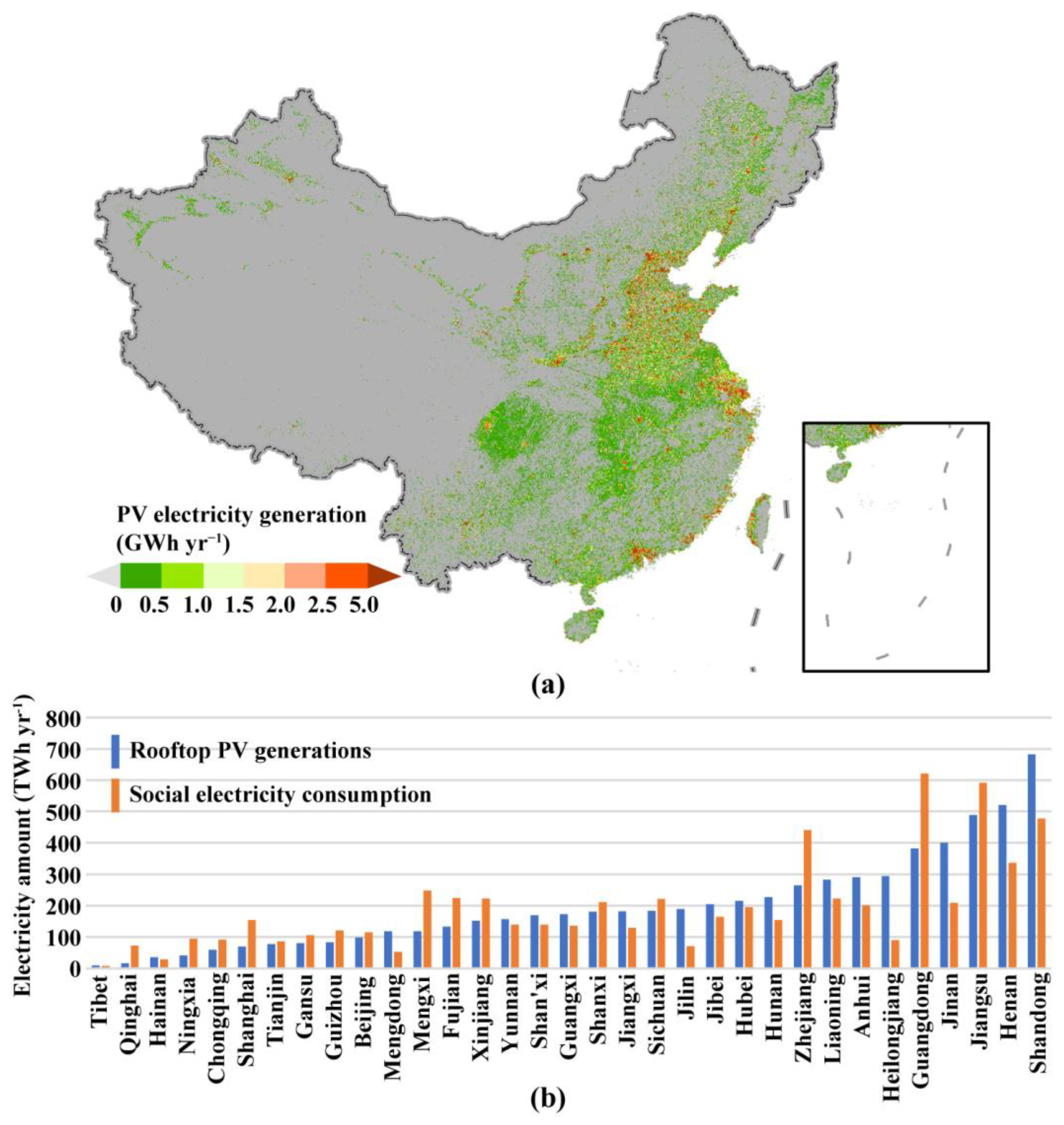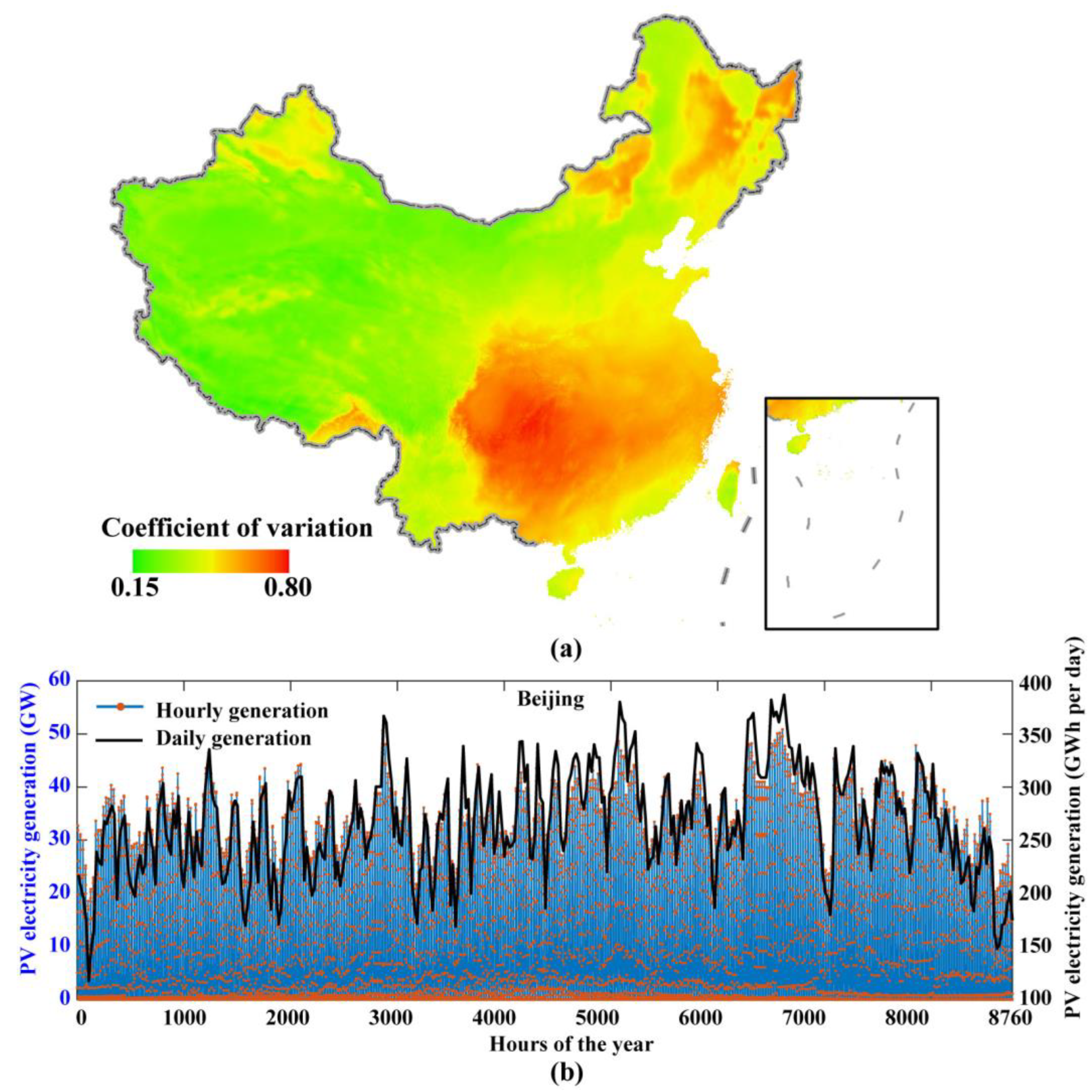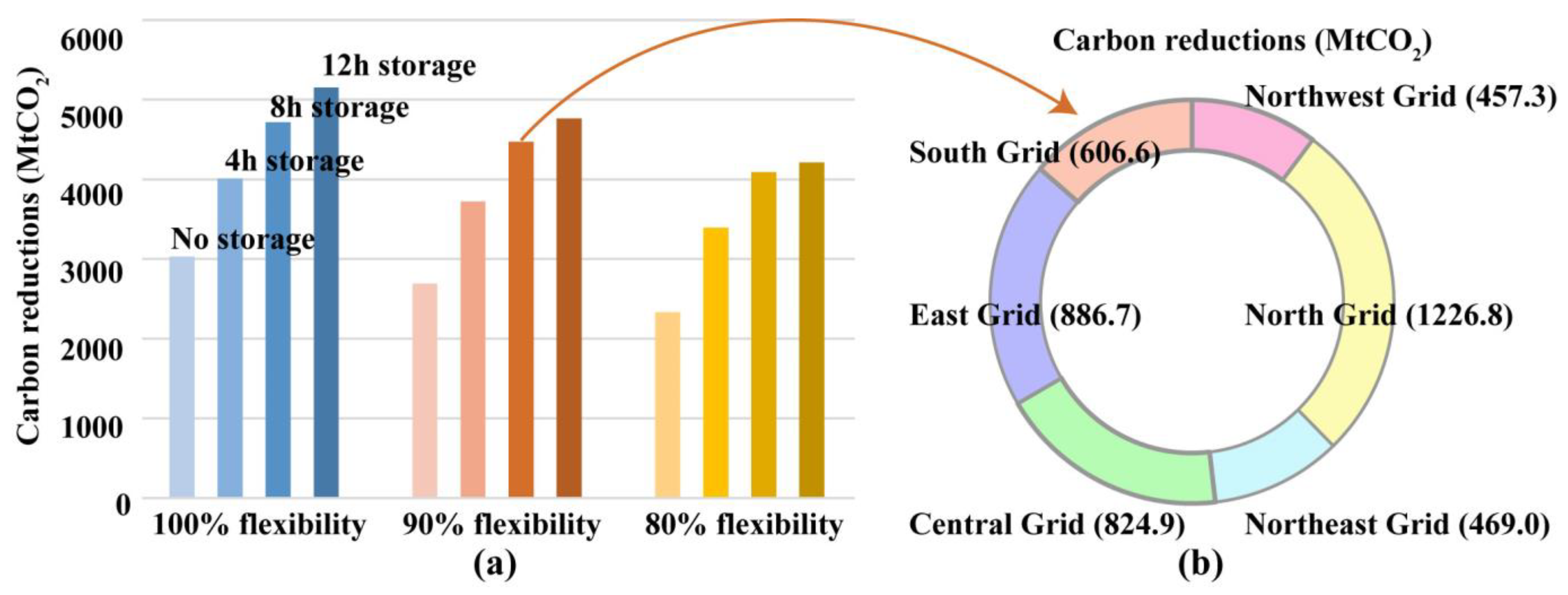Assessing Carbon Reduction Potential of Rooftop PV in China through Remote Sensing Data-Driven Simulations
Abstract
:1. Introduction
- (1)
- The high-resolution mapping of the distribution of China’s rooftop PV potential. An empirical relationship was established to estimate the rooftop area from the settlement area. Multi-source remote sensing data were integrated to simulate the spatio-temporal variation in rooftop PV electricity generation.
- (2)
- The technical framework for calibrating the overestimation of carbon emission reduction. Rooftop PV generation curves and customer-side load profiles were combined to obtain the PV curtailment rates during electricity dispatch. Current PV penetration rates were used to calibrate the grid emission factors for PV-specific ones.
- (3)
- The quantification of carbon reductions in China’s rooftop PV. We designed twelve scenarios with 80%, 90%, and 100% flexibility and 0, 4, 8, and 12 h of storage capacity to reflect the differences in the grid’s ability to absorb intermittent PV electricity.
2. Materials and Methods
2.1. Estimation of Rooftop Resources
2.2. Simulation of PV Generation
2.3. Calculation of Carbon Reductions
3. Results
3.1. Electricity Generation Potential
3.2. Carbon Reduction Potential
4. Discussion
5. Conclusions
- (1)
- The maximum electricity generation of rooftop PV in China reached 6.5 PWh yr−1, of which more than 80% was concentrated in densely populated areas in the east and characterized by high variability.
- (2)
- Unlocking China’s full rooftop PV potential could reduce CO2 equivalent emissions by 2.3–5.2 Gt, depending on the grid flexibility and storage capacity.
- (3)
- The potential carbon reductions could offset 21%–47% of China’s total emissions, using the data in 2019 as a reference; thus, it could make a significant contribution to carbon neutrality.
- (4)
- Both carbon reductions and their offset rates vary greatly from grid to grid, highlighting the need for rooftop PV development plans tailored to local conditions.
Author Contributions
Funding
Institutional Review Board Statement
Informed Consent Statement
Data Availability Statement
Conflicts of Interest
References
- Chen, X.; Liu, Y.; Wang, Q.; Lv, J.; Wen, J.; Chen, X.; Kang, C.; Cheng, S.; McElroy, M.B. Pathway toward carbon-neutral electrical systems in China by mid-century with negative CO2 abatement costs informed by high-resolution modeling. Joule 2021, 5, 2715–2741. [Google Scholar] [CrossRef]
- Lu, X.; Chen, S.; Nielsen Chris, P.; Zhang, C.; Li, J.; Xu, H.; Wu, Y.; Wang, S.; Song, F.; Wei, C.; et al. Combined solar power and storage as cost-competitive and grid-compatible supply for China’s future carbon-neutral electricity system. Proc. Natl. Acad. Sci. USA 2021, 118, e2103471118. [Google Scholar] [CrossRef] [PubMed]
- IEA. Solar PV; International Energy Agency (IEA): Paris, France, 2022. [Google Scholar]
- Liu, L.; Sun, Q.; Li, H.; Yin, H.; Ren, X.; Wennersten, R. Evaluating the benefits of integrating floating photovoltaic and pumped storage power system. Energy Convers. Manag. 2019, 194, 173–185. [Google Scholar] [CrossRef]
- Xue, J. Photovoltaic agriculture—New opportunity for photovoltaic applications in China. Renew. Sustain. Energy Rev. 2017, 73, 1–9. [Google Scholar] [CrossRef]
- Cheng, C.L.; Sanchez Jimenez, C.S.; Lee, M.-C. Research of BIPV optimal tilted angle, use of latitude concept for south orientated plans. Renew. Energy 2009, 34, 1644–1650. [Google Scholar] [CrossRef]
- Jiang, H.; Yao, L.; Lu, N.; Qin, J.; Liu, T.; Liu, Y.; Zhou, C. Geospatial assessment of rooftop solar photovoltaic potential using multi-source remote sensing data. Energy AI 2022, 10, 100185. [Google Scholar] [CrossRef]
- Bódis, K.; Kougias, I.; Jäger-Waldau, A.; Taylor, N.; Szabó, S. A high-resolution geospatial assessment of the rooftop solar photovoltaic potential in the European Union. Renew. Sustain. Energy Rev. 2019, 114, 109309. [Google Scholar] [CrossRef]
- Sacchelli, S.; Garegnani, G.; Geri, F.; Grilli, G.; Paletto, A.; Zambelli, P.; Ciolli, M.; Vettorato, D. Trade-off between photovoltaic systems installation and agricultural practices on arable lands: An environmental and socio-economic impact analysis for Italy. Land Use Policy 2016, 56, 90–99. [Google Scholar] [CrossRef]
- NEA. Notice of Publishing the List of Pilot Projects for Distributed Rooftop Photovoltaic Development in the Whole County (City or District). Available online: http://zfxxgk.nea.gov.cn/2021-09/08/c_1310186582.htm (accessed on 30 December 2022).
- Gassar, A.A.A.; Cha, S.H. Review of geographic information systems-based rooftop solar photovoltaic potential estimation approaches at urban scales. Appl. Energy 2021, 291, 116817. [Google Scholar] [CrossRef]
- Mohajeri, N.; Assouline, D.; Guiboud, B.; Bill, A.; Gudmundsson, A.; Scartezzini, J.-L. A city-scale roof shape classification using machine learning for solar energy applications. Renew. Energy 2018, 121, 81–93. [Google Scholar] [CrossRef]
- Machete, R.; Falcão, A.P.; Gomes, M.G.; Moret Rodrigues, A. The use of 3d GIS to analyse the influence of urban context on buildings’ solar energy potential. Energy Build. 2018, 177, 290–302. [Google Scholar] [CrossRef]
- Wu, A.N.; Biljecki, F. Roofpedia: Automatic mapping of green and solar roofs for an open roofscape registry and evaluation of urban sustainability. Landsc. Urban Plan. 2021, 214, 104167. [Google Scholar] [CrossRef]
- Debbarma, M.; Sudhakar, K.; Baredar, P. Thermal modeling, exergy analysis, performance of BIPV and BIPVT: A review. Renew. Sustain. Energy Rev. 2017, 73, 1276–1288. [Google Scholar] [CrossRef]
- Hong, T.; Koo, C.; Park, J.; Park, H.S. A GIS (geographic information system)-based optimization model for estimating the electricity generation of the rooftop PV (photovoltaic) system. Energy 2014, 65, 190–199. [Google Scholar] [CrossRef]
- Bergamasco, L.; Asinari, P. Scalable methodology for the photovoltaic solar energy potential assessment based on available roof surface area: Application to piedmont region (Italy). Sol. Energy 2011, 85, 1041–1055. [Google Scholar] [CrossRef]
- Assouline, D.; Mohajeri, N.; Scartezzini, J.-L. Quantifying rooftop photovoltaic solar energy potential: A machine learning approach. Sol. Energy 2017, 141, 278–296. [Google Scholar] [CrossRef]
- Zhong, T.; Zhang, Z.; Chen, M.; Zhang, K.; Zhou, Z.; Zhu, R.; Wang, Y.; Lü, G.; Yan, J. A city-scale estimation of rooftop solar photovoltaic potential based on deep learning. Appl. Energy 2021, 298, 117132. [Google Scholar] [CrossRef]
- Huang, J.; Zhang, X.; Xin, Q.; Sun, Y.; Zhang, P. Automatic building extraction from high-resolution aerial images and LiDAR data using gated residual refinement network. ISPRS J. Photogramm. Remote Sens. 2019, 151, 91–105. [Google Scholar] [CrossRef]
- Guo, H.; Du, B.; Zhang, L.; Su, X. A coarse-to-fine boundary refinement network for building footprint extraction from remote sensing imagery. ISPRS J. Photogramm. Remote Sens. 2022, 183, 240–252. [Google Scholar] [CrossRef]
- Guo, H.; Shi, Q.; Marinoni, A.; Du, B.; Zhang, L. Deep building footprint update network: A semi-supervised method for updating existing building footprint from bi-temporal remote sensing images. Remote Sens. Env. 2021, 264, 112589. [Google Scholar] [CrossRef]
- Peng, Z.; Letu, H.; Wang, T.; Shi, C.; Zhao, C.; Tana, G.; Zhao, N.; Dai, T.; Tang, R.; Shang, H.; et al. Estimation of shortwave solar radiation using the artificial neural network from Himawari-8 satellite imagery over China. J. Quant. Spectrosc. Radiat. Transf. 2020, 240, 106672. [Google Scholar] [CrossRef]
- Jiang, H.; Lu, N.; Qin, J.; Tang, W.J.; Yao, L. A deep learning algorithm to estimate hourly global solar radiation from geostationary satellite data. Renew. Sustain. Energy Rev. 2019, 114, 109327. [Google Scholar] [CrossRef]
- Huang, G.H.; Li, Z.Q.; Li, X.; Liang, S.L.; Yang, K.; Wang, D.D.; Zhang, Y. Estimating surface solar irradiance from satellites: Past, present, and future perspectives. Remote Sens. Environ. 2019, 233, 111371. [Google Scholar] [CrossRef]
- Li, R.; Wang, D.; Liang, S.; Jia, A.; Wang, Z. Estimating global downward shortwave radiation from VIIRS data using a transfer-learning neural network. Remote Sens. Env. 2022, 274, 112999. [Google Scholar] [CrossRef]
- Joshi, S.; Mittal, S.; Holloway, P.; Shukla, P.R.; Ó Gallachóir, B.; Glynn, J. High resolution global spatiotemporal assessment of rooftop solar photovoltaics potential for renewable electricity generation. Nat. Commun. 2021, 12, 5738. [Google Scholar] [CrossRef]
- Abd Latif, Z.; Mohd Zaki, N.; Salleh, S. GIS-based estimation of rooftop solar photovoltaic potential using LiDAR. In Proceedings of the 2012 IEEE 8th International Colloquium on Signal Processing and Its Applications, Mahkota, Malaysia, 23–25 March 2012; pp. 388–392. [Google Scholar]
- Mesude Bayrakci, B.; Kirby, C.; Jeffrey, R.S.B. An automated model for rooftop PV systems assessment in ArcGIS using LiDAR. AIMS Energy 2015, 3, 401–420. [Google Scholar] [CrossRef]
- Jacques, D.A.; Gooding, J.; Giesekam, J.J.; Tomlin, A.S.; Crook, R. Methodology for the assessment of PV capacity over a city region using low-resolution LiDAR data and application to the city of Leeds (UK). Appl. Energy 2014, 124, 28–34. [Google Scholar] [CrossRef]
- Gagnon, P.; Margolis, R.; Melius, J.; Phillips, C.; Elmore, R. Estimating rooftop solar technical potential across the us using a combination of GIS-based methods, lidar data, and statistical modeling. Environ. Res. Lett. 2018, 13, 024027. [Google Scholar] [CrossRef]
- Wang, M.; Mao, X.; Gao, Y.; He, F. Potential of carbon emission reduction and financial feasibility of urban rooftop photovoltaic power generation in Beijing. J. Clean. Prod. 2018, 203, 1119–1131. [Google Scholar] [CrossRef]
- Taborianski, V.M.; Pacca, S.A. Carbon dioxide emission reduction potential for low income housing units based on photovoltaic systems in distinct climatic regions. Renew. Energy 2022, 198, 1440–1447. [Google Scholar] [CrossRef]
- Knuepfer, K.; Rogalski, N.; Knuepfer, A.; Esteban, M.; Shibayama, T. A reliable energy system for Japan with merit order dispatch, high variable renewable share and no nuclear power. Appl. Energy 2022, 328, 119840. [Google Scholar] [CrossRef]
- Zhang, X.; Wang, J.-X.; Cao, Z.; Shen, S.; Meng, S.; Fan, J.-L. What is driving the remarkable decline of wind and solar power curtailment in China? Evidence from China and four typical provinces. Renew. Energy 2021, 174, 31–42. [Google Scholar] [CrossRef]
- Denholm, P.; Hand, M. Grid flexibility and storage required to achieve very high penetration of variable renewable electricity. Energy Policy 2011, 39, 1817–1830. [Google Scholar] [CrossRef]
- Ziegler, M.S.; Mueller, J.M.; Pereira, G.D.; Song, J.; Ferrara, M.; Chiang, Y.-M.; Trancik, J.E. Storage requirements and costs of shaping renewable energy toward grid decarbonization. Joule 2019, 3, 2134–2153. [Google Scholar] [CrossRef]
- Wang, B.; Ji, F.; Zheng, J.; Xie, K.; Feng, Z. Carbon emission reduction of coal-fired power supply chain enterprises under the revenue sharing contract: Perspective of coordination game. Energy Econ. 2021, 102, 105467. [Google Scholar] [CrossRef]
- Pfenninger, S.; Staffell, I. Long-term patterns of European PV output using 30 years of validated hourly reanalysis and satellite data. Energy 2016, 114, 1251–1265. [Google Scholar] [CrossRef]
- Hargreaves, J.; Hart, E.K.; Jones, R.; Olson, A. Reflex: An adapted production simulation methodology for flexible capacity planning. IEEE Trans. Power Syst. 2015, 30, 1306–1315. [Google Scholar] [CrossRef]
- Zhou, K.; Lindenbergh, R.; Gorte, B.; Zlatanova, S. Lidar-guided dense matching for detecting changes and updating of buildings in airborne lidar data. ISPRS J. Photogramm. Remote Sens. 2020, 162, 200–213. [Google Scholar] [CrossRef]
- Esch, T.; Brzoska, E.; Dech, S.; Leutner, B.; Palacios-Lopez, D.; Metz-Marconcini, A.; Marconcini, M.; Roth, A.; Zeidler, J. World settlement footprint 3d—A first three-dimensional survey of the global building stock. Remote Sens. Env. 2022, 270, 112877. [Google Scholar] [CrossRef]
- Marconcini, M.; Metz-Marconcini, A.; Üreyen, S.; Palacios-Lopez, D.; Hanke, W.; Bachofer, F.; Zeidler, J.; Esch, T.; Gorelick, N.; Kakarla, A.; et al. Outlining where humans live, the world settlement footprint 2015. Sci. Data 2020, 7, 242. [Google Scholar] [CrossRef]
- Liu, P.; Liu, X.; Liu, M.; Shi, Q.; Yang, J.; Xu, X.; Zhang, Y. Building footprint extraction from high-resolution images via spatial residual inception convolutional neural network. Remote Sens. 2019, 11, 830. [Google Scholar] [CrossRef]
- Liu, T.; Yao, L.; Qin, J.; Lu, N.; Jiang, H.; Zhang, F.; Zhou, C. Multi-scale attention integrated hierarchical networks for high-resolution building footprint extraction. Int. J. Appl. Earth Obs. Geoinf. 2022, 109, 102768. [Google Scholar] [CrossRef]
- Jiang, H.; Lu, N.; Qin, J.; Yao, L. Hourly 5-km surface total and diffuse solar radiation in China, 2007–2018. Sci. Data 2020, 7, 311. [Google Scholar] [CrossRef]
- Jiang, H.; Yang, Y.; Wang, H.; Bai, Y.; Bai, Y. Surface diffuse solar radiation determined by reanalysis and satellite over east Asia: Evaluation and comparison. Remote Sens. 2020, 12, 1387. [Google Scholar] [CrossRef]
- Liu, Y.; Yao, L.; Jiang, H.; Lu, N.; Qin, J.; Liu, T.; Zhou, C. Spatial estimation of the optimum PV tilt angles in China by incorporating ground with satellite data. Renew. Energy 2022, 189, 1249–1258. [Google Scholar] [CrossRef]
- Munoz-Sabater, J.; Dutra, E.; Agusti-Panareda, A.; Albergel, C.; Arduini, G.; Balsamo, G.; Boussetta, S.; Choulga, M.; Harrigan, S.; Hersbach, H.; et al. Era5-land: A state-of-the-art global reanalysis dataset for land applications. Earth Syst. Sci. Data 2021, 13, 4349–4383. [Google Scholar] [CrossRef]
- Wu, C.; Zhang, X.-P.; Sterling, M. Solar power generation intermittency and aggregation. Sci. Rep. 2022, 12, 1363. [Google Scholar] [CrossRef]
- IPCC. Chapter 2: Stationary combustion. In 2006 IPCC Guidelines for National Greenhouse Gas Inventories Volume 2: Energy; Intergovernmental Panel on Climate Change; IPCC: Geneva, Switzerland, 2006. [Google Scholar]
- Typical Load Profiles of Provincial Power Grid. Available online: https://www.ndrc.gov.cn/xwdt/tzgg/202012/P020201202546044875868.pdf (accessed on 1 August 2022).
- China’s Regional Grid Emissions Factors. 2019. Available online: https://www.mee.gov.cn/ywgz/ydqhbh/wsqtkz/202012/t20201229_815386.shtml (accessed on 1 August 2022).
- Guan, Y.; Shan, Y.; Huang, Q.; Chen, H.; Wang, D.; Hubacek, K. Assessment to China’s recent emission pattern shifts. Earth’s Future 2021, 9, e2021EF002241. [Google Scholar] [CrossRef]
- Qin, J.; Jiang, H.; Lu, N.; Yao, L.; Zhou, C. Enhancing solar PV output forecast by integrating ground and satellite observations with deep learning. Renew. Sustain. Energy Rev. 2022, 167, 112680. [Google Scholar] [CrossRef]
- Bravo, R.; Ortiz, C.; Chacartegui, R.; Friedrich, D. Multi-objective optimisation and guidelines for the design of dispatchable hybrid solar power plants with thermochemical energy storage. Appl. Energy 2021, 282, 116257. [Google Scholar] [CrossRef]
- Asadi Majd, A.; Farjah, E.; Rastegar, M.; Bacha, S. Generation and transmission expansion planning for bulk renewable energy export considering transmission service cost allocation. Electr. Power Syst. Res. 2021, 196, 107197. [Google Scholar] [CrossRef]
- Sánchez de la Nieta, A.A.; Paterakis, N.G.; Gibescu, M. Participation of photovoltaic power producers in short-term electricity markets based on rescheduling and risk-hedging mapping. Appl. Energy 2020, 266, 114741. [Google Scholar] [CrossRef]
- Mallapaty, S. How China could be carbon neutral by mid-century. Nature 2020, 586, 482–483. [Google Scholar] [CrossRef] [PubMed]
- Liu, L.; Wang, Y.; Wang, Z.; Li, S.; Li, J.; He, G.; Li, Y.; Liu, Y.; Piao, S.; Gao, Z.; et al. Potential contributions of wind and solar power to China’s carbon neutrality. Resour. Conserv. Recycl. 2022, 180, 106155. [Google Scholar] [CrossRef]










| 100% Flexibility | 90% Flexibility | 80% Flexibility | ||||||||||
|---|---|---|---|---|---|---|---|---|---|---|---|---|
| 0 h | 4 h | 8 h | 12 h | 0 h | 4 h | 8 h | 12 h | 0 h | 4 h | 8 h | 12 h | |
| Xinjiang | 111.5 | 153.1 | 166.5 | 166.8 | 101.9 | 145.3 | 165.8 | 166.8 | 91.6 | 136.1 | 163.8 | 166.4 |
| Tibet | 3.6 | 4.8 | 5.9 | 6.6 | 3.0 | 4.3 | 5.3 | 5.6 | 2.5 | 3.7 | 4.4 | 4.5 |
| Qinghai | 20.4 | 20.4 | 20.4 | 20.4 | 20.4 | 20.4 | 20.4 | 20.4 | 20.3 | 20.4 | 20.4 | 20.4 |
| Gansu | 59.8 | 82.6 | 95.6 | 96.6 | 54.2 | 77.5 | 93.9 | 96.5 | 48.2 | 71.8 | 90.8 | 94.5 |
| Ningxia | 47.2 | 54.6 | 54.6 | 54.6 | 43.9 | 54.5 | 54.6 | 54.6 | 39.9 | 54.3 | 54.6 | 54.6 |
| Shan’xi | 74.6 | 100.6 | 126.0 | 144.5 | 65.6 | 91.6 | 117.2 | 128.5 | 56.2 | 82.2 | 102.8 | 107.7 |
| Beijing | 54.4 | 73.4 | 86.8 | 89.6 | 47.5 | 67.0 | 80.5 | 83.2 | 39.9 | 59.2 | 68.8 | 70.3 |
| Tianjin | 41.5 | 56.4 | 68.0 | 72.3 | 36.7 | 51.8 | 64.6 | 68.5 | 31.6 | 46.8 | 58.0 | 59.7 |
| Jibei | 92.4 | 125.5 | 158.2 | 186.6 | 82.2 | 115.4 | 148.3 | 168.9 | 71.6 | 104.7 | 136.9 | 144.9 |
| Jinan | 129.8 | 172.1 | 214.3 | 245.4 | 113.9 | 156.2 | 197.3 | 213.0 | 97.5 | 139.7 | 171.4 | 176.1 |
| Shanxi | 117.9 | 162.2 | 196.5 | 208.3 | 105.7 | 150.7 | 188.8 | 204.2 | 92.7 | 138.0 | 178.6 | 188.9 |
| Shandong | 253.3 | 341.1 | 428.3 | 504.1 | 221.9 | 309.7 | 396.0 | 442.8 | 189.2 | 277.0 | 354.5 | 367.4 |
| Mengxi | 124.9 | 151.2 | 151.3 | 151.3 | 115.8 | 150.7 | 151.3 | 151.3 | 105.3 | 148.4 | 151.3 | 151.3 |
| Mengdong | 43.3 | 57.6 | 71.9 | 84.0 | 37.9 | 52.2 | 66.5 | 72.7 | 32.4 | 46.7 | 59.1 | 60.3 |
| Heilongjiang | 70.9 | 92.8 | 114.7 | 127.0 | 62.7 | 84.6 | 104.7 | 110.9 | 54.4 | 76.3 | 90.6 | 92.8 |
| Jilin | 54.4 | 71.6 | 88.8 | 98.9 | 48.1 | 65.3 | 80.8 | 86.6 | 41.7 | 58.9 | 70.2 | 72.9 |
| Liaoning | 134.3 | 183.1 | 230.3 | 271.1 | 120.4 | 169.3 | 217.0 | 247.1 | 106.0 | 154.8 | 202.3 | 216.3 |
| Sichuan | 100.0 | 135.2 | 158.6 | 163.5 | 88.2 | 124.3 | 152.2 | 158.1 | 75.4 | 112.0 | 136.9 | 139.5 |
| Chongqing | 37.6 | 48.8 | 51.5 | 51.5 | 32.8 | 45.8 | 50.8 | 51.2 | 27.2 | 41.1 | 44.9 | 45.1 |
| Henan | 168.2 | 225.7 | 283.2 | 330.4 | 143.9 | 201.5 | 258.5 | 282.1 | 118.7 | 176.3 | 218.9 | 225.9 |
| Hubei | 93.2 | 126.2 | 156.9 | 176.8 | 80.8 | 113.9 | 145.0 | 156.9 | 67.6 | 100.7 | 124.6 | 129.7 |
| Hunan | 78.7 | 105.0 | 131.1 | 149.4 | 67.9 | 94.2 | 118.7 | 128.3 | 56.6 | 82.9 | 99.8 | 103.7 |
| Jiangxi | 64.3 | 86.3 | 108.1 | 125.3 | 56.4 | 78.3 | 99.7 | 110.0 | 48.0 | 70.0 | 87.5 | 91.1 |
| Anhui | 89.4 | 120.7 | 151.9 | 177.6 | 76.4 | 107.8 | 138.5 | 152.7 | 62.9 | 94.2 | 117.6 | 123.0 |
| Jiangsu | 242.2 | 330.3 | 389.8 | 406.6 | 214.6 | 305.0 | 373.3 | 394.4 | 184.8 | 276.0 | 346.4 | 358.3 |
| Shanghai | 48.5 | 55.2 | 55.4 | 55.4 | 44.5 | 54.5 | 55.4 | 55.4 | 39.1 | 53.0 | 54.9 | 55.2 |
| Zhejiang | 162.3 | 205.7 | 212.0 | 212.5 | 146.8 | 197.9 | 209.1 | 210.0 | 129.0 | 184.4 | 203.4 | 204.4 |
| Fujian | 84.2 | 107.8 | 110.7 | 110.8 | 76.8 | 104.5 | 110.4 | 110.6 | 68.4 | 99.1 | 109.0 | 109.5 |
| Yunnan | 67.7 | 91.5 | 114.4 | 130.7 | 60.8 | 84.6 | 107.9 | 118.9 | 53.7 | 77.4 | 99.1 | 102.9 |
| Guizhou | 51.2 | 68.3 | 73.7 | 73.9 | 45.4 | 63.9 | 72.9 | 73.5 | 38.9 | 58.2 | 67.4 | 68.1 |
| Guangxi | 64.4 | 86.2 | 107.9 | 124.9 | 56.5 | 78.4 | 99.9 | 109.3 | 48.2 | 70.1 | 87.7 | 89.7 |
| Guangdong | 230.1 | 299.2 | 310.8 | 311.2 | 207.2 | 286.2 | 306.4 | 307.5 | 180.9 | 265.2 | 297.4 | 299.8 |
| Hainan | 12.5 | 16.8 | 21.1 | 24.6 | 11.0 | 15.3 | 19.6 | 21.8 | 9.5 | 13.8 | 17.6 | 18.2 |
| Total | 3028.8 | 4011.9 | 4715.0 | 5153.1 | 2691.9 | 3722.3 | 4471.2 | 4762.1 | 2329.9 | 3393.5 | 4091.4 | 4212.7 |
Disclaimer/Publisher’s Note: The statements, opinions and data contained in all publications are solely those of the individual author(s) and contributor(s) and not of MDPI and/or the editor(s). MDPI and/or the editor(s) disclaim responsibility for any injury to people or property resulting from any ideas, methods, instructions or products referred to in the content. |
© 2023 by the authors. Licensee MDPI, Basel, Switzerland. This article is an open access article distributed under the terms and conditions of the Creative Commons Attribution (CC BY) license (https://creativecommons.org/licenses/by/4.0/).
Share and Cite
Jiang, H.; Lu, N.; Wang, X. Assessing Carbon Reduction Potential of Rooftop PV in China through Remote Sensing Data-Driven Simulations. Sustainability 2023, 15, 3380. https://doi.org/10.3390/su15043380
Jiang H, Lu N, Wang X. Assessing Carbon Reduction Potential of Rooftop PV in China through Remote Sensing Data-Driven Simulations. Sustainability. 2023; 15(4):3380. https://doi.org/10.3390/su15043380
Chicago/Turabian StyleJiang, Hou, Ning Lu, and Xuecheng Wang. 2023. "Assessing Carbon Reduction Potential of Rooftop PV in China through Remote Sensing Data-Driven Simulations" Sustainability 15, no. 4: 3380. https://doi.org/10.3390/su15043380
APA StyleJiang, H., Lu, N., & Wang, X. (2023). Assessing Carbon Reduction Potential of Rooftop PV in China through Remote Sensing Data-Driven Simulations. Sustainability, 15(4), 3380. https://doi.org/10.3390/su15043380







